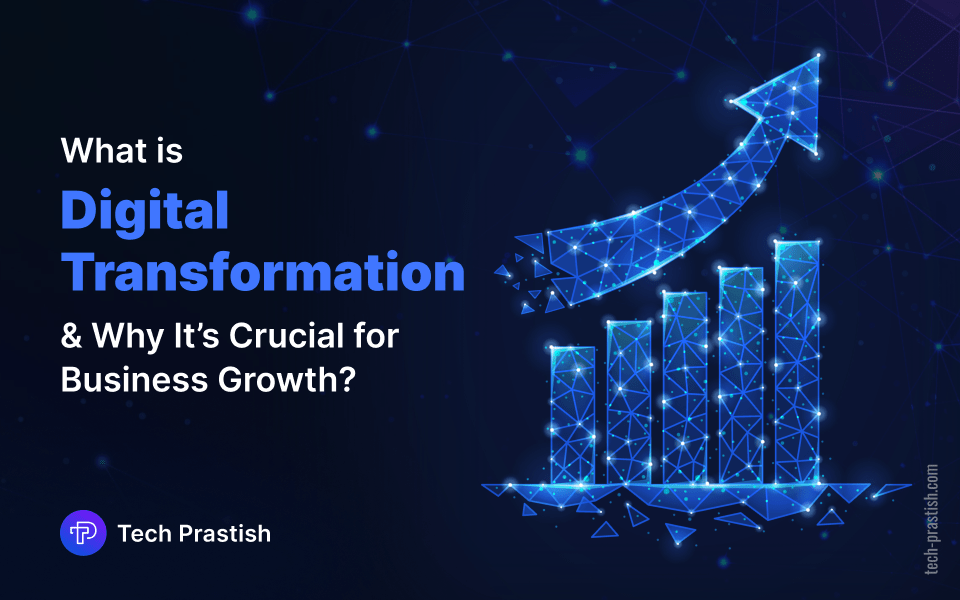
In today’s evolving digital landscape, staying ahead of the competition is crucial for businesses. With every passing day, customer expectations are changing, and it’s necessary for businesses to meet and adapt them to maintain relevance and growth.
Digital transformation is key to business growth. But with so many new technologies emerging, how can your business stay up-to-date and make the most of these opportunities? For businesses, the real challenge is to innovate and deliver exceptional customer experiences. That’s where digital transformation comes in.
Digital transformation has the ability to integrate cutting-edge technologies like Artificial Intelligence (AI), machine learning, the Internet of Things (IoT), advanced analytics, and robotics to help businesses deliver best-in-class experiences to their customers.
Navigating through this digital shift isn’t always easy. There are many hurdles to overcome—whether it’s aligning your people, optimizing your processes, or keeping up with the pace of technological advancements. Yet, with expert guidance, and a comprehensive digital transformation strategy, businesses can scale smarter, reduce operational costs, and unlock new revenue streams.
Digital transformation is more than just a set of technologies; it’s about strategically embedding digital tools into every process of your organization—from customer service to supply chain operations. The result? Increased efficiency, enhanced customer experiences, and sustainable growth.
In this blog, we’ll explore what digital transformation truly means, why it’s critical to business growth, and how you can build a transformation strategy that positions you for long-term success. Let’s dive in and uncover the tools and approaches that will help you stay ahead of the curve and drive future success.
What is Digital Transformation?
Digital transformation is the process by which organizations can integrate digital technology into all their processes and operations to drive fundamental change. It increases efficiency, and agility, and ultimately unlocks new value for employees, customers, and shareholders.
For digital transformation, each organization’s journey is different. For example, sometimes it can be only AI or cloud computing to enhance its customer experience. Every case is different; so, getting started with your digital transformation journey requires a new mindset to reimagine how your company operates and analyze different processes.
There are two concepts related to digital transformation — digitization and digitalization.
- Digitization – Translating analog information and data into digital form. E.g., scanning a photo or document and storing it on a computer.
- Digitalization – Use of digital technologies to optimize business processes and projects. E.g., upskilling and training employees on new software platforms that accelerate product launches and enhance operational efficiency.
Digital transformation reveals new solutions that can improve customer experience, drive employee innovation, and help your company grow at the fundamental level. Digital transformation (DT or DX) can involve various activities, starting from automating manual processes to developing new digital products and services. Irrespective of the business type and size, it impacts and helps you stay competitive and relevant.
What Are the Key Components of Digital Transformation?
Technology is the driving force behind digital transformation (DT). It often emphasizes transitioning outdated applications and processes to improve customer experiences and create new capabilities for businesses. As per the research, CIOs spend an average of 72% of their budgets on existing IT concerns, whereas only 28% goes to new projects and innovation.
Forrester’s research reaffirms why there is a significant investment in existing IT systems. The report suggests that CIOs spend an average of 72% of their budgets on existing IT concerns. In comparison, only 28% goes to new projects and innovation. Digital transformation is not just about implementing new technologies, it is about transforming business processes, organizational culture, and customer experiences. To dive deep into the digital transformation concept, it’s essential to explore the key components that make up a successful digital transformation journey.
Some key components typically include the following:
1. Digital Strategy
Digital strategy is designed based on the reason for the change and the ultimate objective. Each business is unique and it demands a customized strategy to drive desired results.
2. Data Analytics
The digital transformation uses innovative technologies, tools, and techniques needed to analyze the data gathered from multiple sources. It helps businesses improve their operational efficiency.
3. Customer-centered Approach
Digital transformation focuses on the needs and expectations of your customers to make your business more efficient, profitable, and up-to-date.
4. Processes
Optimizing processes is one of the key components of digital transformation to leverage digital technologies effectively, reduce cost, and improve quality.
5. Technology
Using the most suitable and advanced technologies like cloud computing, big data analytics, artificial intelligence, the Internet of Things (IoT), etc. to transform business operations.
6. Culture
Fostering a culture of innovation, agility, and continuous improvement, embracing the latest advancements, and encouraging employees to experiment, learn and adapt to them.
Why is Digital Transformation Important for Businesses?
Digital transformation significantly reduces cost by automating the manual processes and streamlining operations. To increase operational efficiency, it integrates digital technologies into all aspects of a business. According to research, the digital transformation market is expected to grow around 19.1% annually. If you are still wondering why digital transformation is important for businesses, here are some ways to understand:
Transforming Customer Experience
Enable businesses to offer personalized, seamless, and faster customer experiences, meeting evolving business needs.
Data-driven Insights
Digital transformation helps businesses make informed decisions, identify trends, and predict customer behavior, thus leading to more-targeted strategies and improved outcomes. Data-driven decisions increase operational efficiency and profitability.
Collaboration Across Different Departments
It fosters collaboration and communication by breaking down silos between departments using various digital tools. This ensures smoother workflows, enhances decision-making, and promotes a unified approach to reach your business goals.
Improved Agility and Innovation
Digital transformation enables businesses adapt to market changes and customer demands quickly. With modern tools, companies can innovate faster and respond more effectively to new opportunities or challenges.
Competitive Advantage
Adopting the latest digital technologies keeps businesses ahead of their competitors by offering superior customer experiences, efficient operations, and quicker responses to market shifts.
Cost Reduction
Digital transformation optimizes business operations and streamlines processes, leading to cost savings. Automation, cloud technologies, and improved efficiencies minimize expenses while maximizing productivity and resource allocation.
Process Automation
Automating repetitive tasks and business processes reduces human error and increases efficiency. This allows employees to focus on higher-value tasks while speeding up overall business operations.
Data Centralization
Centralizing data in a single platform ensures consistency and easier access, improving decision-making and operational efficiency. It allows for real-time insights, better customer interactions, and greater business agility.
Legacy System Modernization
Modernizing outdated systems ensures better integration with the latest technologies while improving operational performance. It enhances scalability, reduces maintenance costs, and prepares businesses for future growth and innovation.
How Does Digital Transformation Help Businesses Grow?
Let’s explore a few ways of digital transformation that can help businesses to stay ahead of the competition:
Innovation
Businesses get the opportunity to innovate faster with new products, services, and business models. By utilizing digital technologies like the cloud, businesses can quickly prototype and test new ideas, gather customer feedback, and iterate based on the results.
New Business Opportunities
Digital transformation acts as a catalyst, thus helping businesses explore new opportunities and driving new revenue streams.
Respond to Market Changes
With the help of real-time data and insights, businesses can adapt to the changing market conditions quickly and meet customer expectations.
Streamline Operations
Businesses can streamline operations by integrating digital technologies into all their processes. This eliminates the need for manual tasks, automates manual processes, and reduces overall costs.
Conclusion
In today’s business landscape, digital transformation is not just a trend—it’s a critical driver of growth, efficiency, and long-term success. By embracing the latest technologies, businesses can meet evolving customer expectations, streamline operations, drive new revenue streams, and gain a competitive edge. Digital transformation is an ongoing journey that requires a clear strategy, commitment to change, and a willingness to innovate. Businesses that successfully navigate this digital revolution will not only survive—they’ll thrive.
Tech Prastish Software Solutions Pvt. Ltd. is an award-winning digital transformation service-providing company. With our expertise in creating meaningful digital success stories for our clients, we can help you with a custom digital transformation strategy that aligns with your goals.
Are you ready to transform your business and unlock its full potential? Get in touch with us today to start your digital transformation journey.
FAQs
1. How can digital transformation improve customer experience?
Digital transformation enhances customer experience by offering personalized, seamless, and faster customer interaction using technologies like AI, cloud computing, and data analytics. Digital transformation works around adopting new technologies, creating or modifying business models, and improving customer experiences, resulting in improved customer satisfaction and loyalty.
2. What role does data play in digital transformation?
Digital transformation plays a key role in identifying trends and predicting customer behavior. This enables businesses to make data-driven decisions using advanced analytics and real-time data insights, optimize operations, and enhance customer experiences.
3. How does digital transformation help businesses stay competitive?
Digital transformation helps businesses innovate faster, meet customer expectations, and deliver a superior customer experience, thus enabling them to stay competitive in the ever-evolving digital landscape.
4. What are the challenges businesses face in digital transformation?
In digital transformation, businesses face challenges like resistance to change, integrating new technologies with legacy systems, and upskilling their employees. However, with expert assistance, a clear strategy, strong leadership, and a focus on innovation, businesses can easily overcome these challenges and successfully navigate through their digital transformation journey.
5. What are the key benefits of digital transformation?
Digital transformation is a necessity for businesses to stay updated and competitive. It involves organizational benefits such as enhanced efficiency, improved customer experience agility, data-driven insights, cost reduction, new revenue streams, and improved security.




